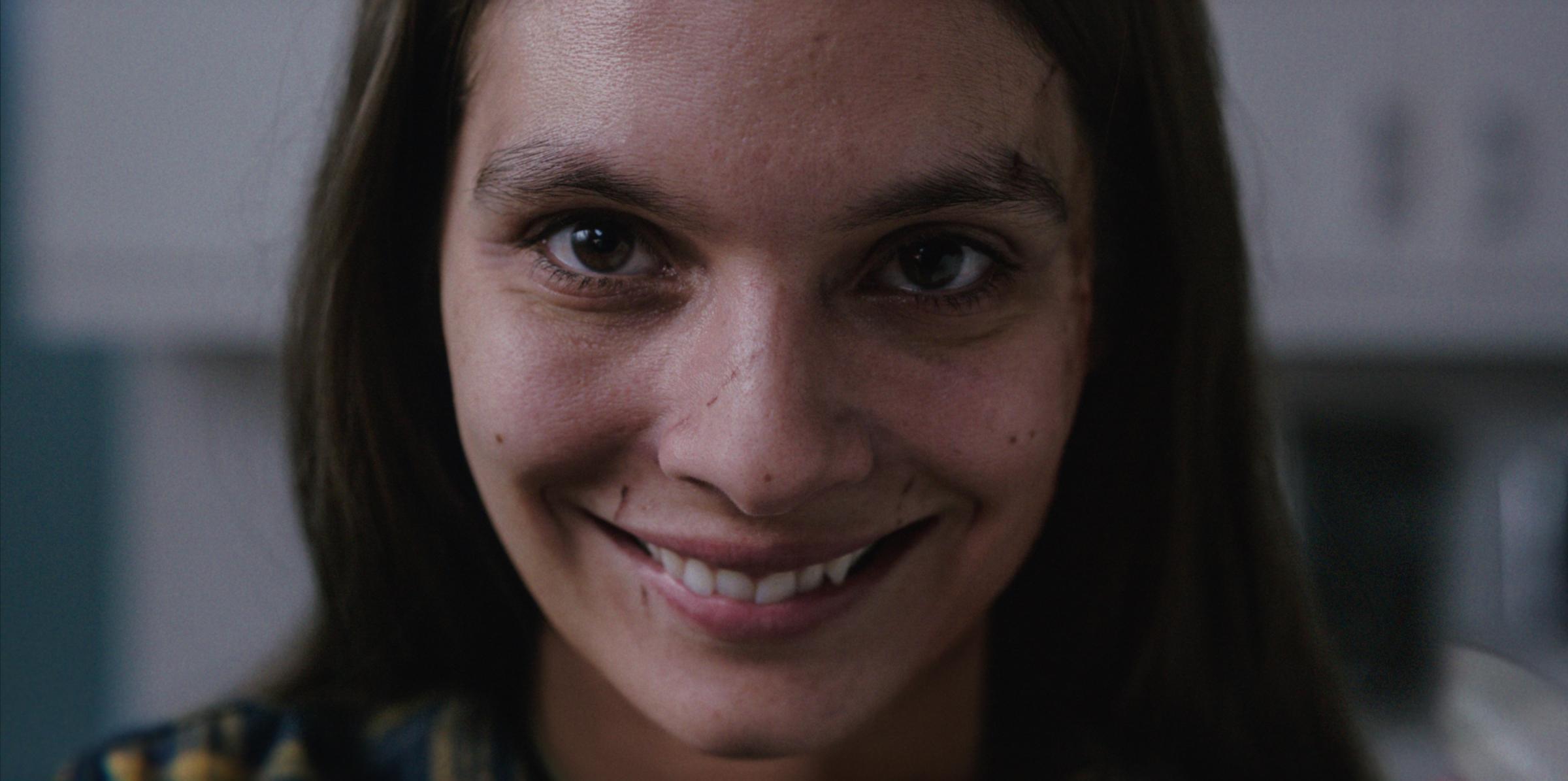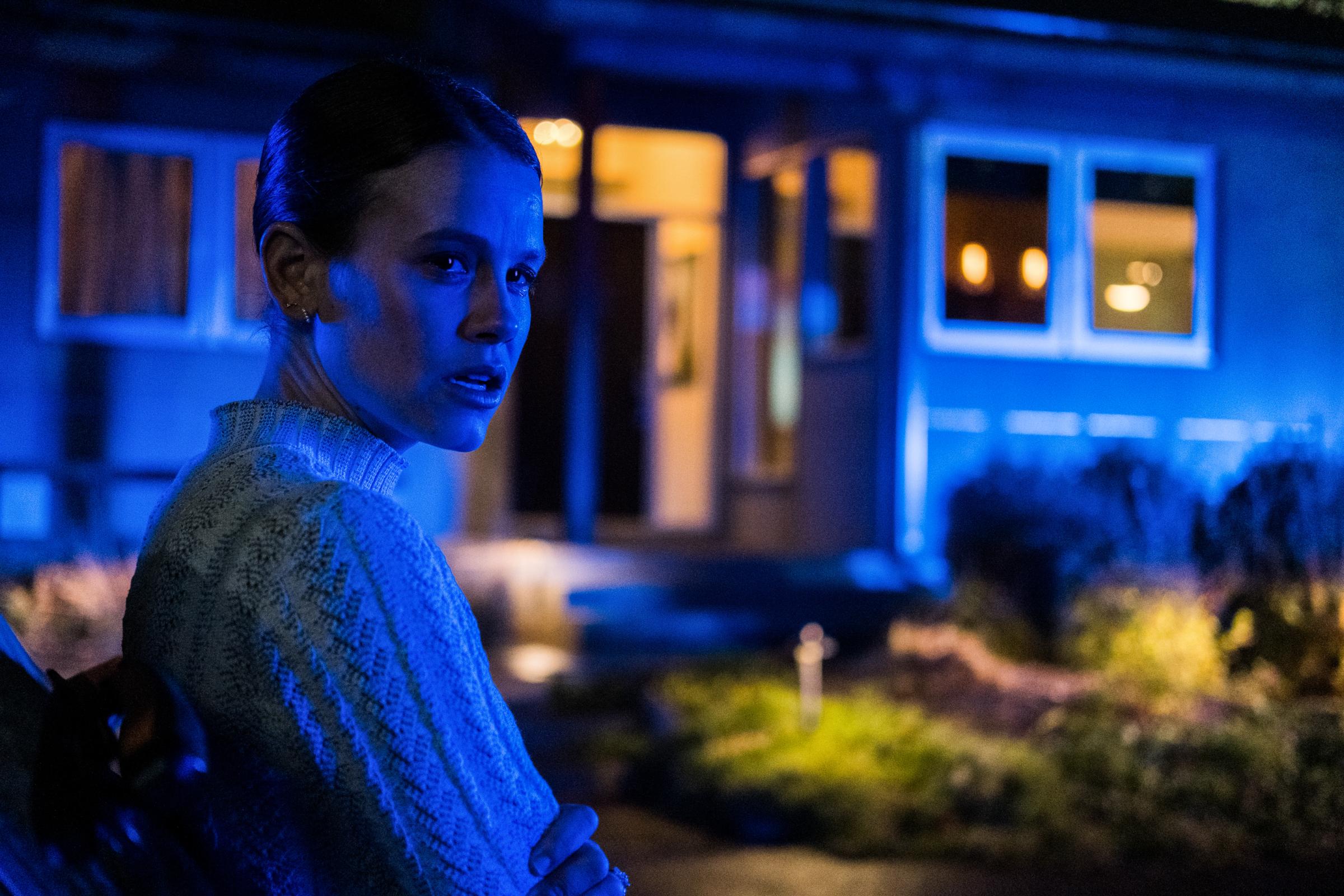Warning: This post contains spoilers for Smile
With a tagline like, “Once you see it, it’s too late,” it’s perhaps not shocking to hear that Smile doesn’t have a happy ending—but the film’s writer and director Parker Finn hopes it’s a poignant one.
The horror movie, in theaters now, follows clinical psychologist Dr. Rose Cotter (played by Sosie Bacon) as she tries to escape a smirking evil entity that is out to kill her. The horrifying presence attaches itself to Rose after she sees Laura (Caitlin Stasey), a patient with no history of mental illness, take her own life. Laura, who, just days earlier, was witness to a gruesome suicide, hurts herself while creepily grinning from ear to ear, making it all the more unsettling.
Rose soon begins to see Laura everywhere she goes, wearing that same teeth-baring smile that the college student had said was haunting her in the moments right before her death. Eventually, the grinning demon begins to take on the form of other people Rose knows including her therapist, in one of the more off putting scenes in the film. Those closest to Rose believe she’s lost her mind and that her hallucinations are a symptom of some undiagnosed mental illness. (Rose’s mom, we learn, took her own life when she was just a kid, and she has not yet processed it fully.) But Rose knows there is an explanation for what’s happening to her, even if it sounds a little far fetched.

What happens in Smile?
Desperate to figure things out, Rose seeks out her ex-boyfriend, police officer Joel (Kyle Gallner), who is the only one willing to really listen to her. With his help, she discovers that the phantom stalking her feeds off of a person’s trauma. Before attaching itself to Rose, the demon affixed itself to 20 other people. Nineteen of those people took their own life within four to seven days after witnessing someone else die by suicide. In hopes of learning how she can save herself, she visits Robert Talley (Rob Morgan), the only person who has managed to stay alive after encountering the grinning demon. His secret? He killed his neighbor in order to stop the chain and is now serving a life sentence. Robert saved himself from certain death, but he didn’t stop the demon. He just passed the buck to some other innocent person who then in turn passed it on to someone else with no real hope of it ever stopping.
Committing murder isn’t a viable solution for Rose. It’s merely a Band-Aid for a much deeper wound. She wants to stop this specter in its tracks without hurting someone else in the process. Realizing that this evil needs a witness to continue its path of deadly destruction, Rose concludes that if she dies and no one is around to see it—and become traumatized—she could, in theory, permanently end this killing spree.
Read More: How Smile Pays Tribute to Horror Classics Like The Ring and Rosemary’s Baby
Five days after witnessing Laura’s death, Rose heads to her childhood home, a decrepit cabin in the woods where her mom died by suicide. The movie often flashes on the horrific scene of Rose opening the door to her mother’s bedroom to find her lifeless body. She has not forgiven herself for the events of that day. Instead of dealing with the trauma, she’s gotten good at numbing the pain with nonstop work or white wine.
It might be why, on the first night at the cabin, the demon comes to her in the form of her mother. She apologizes to Rose for what she had done to herself, but also asks, “Why did you let me die?” In the film’s final act, it’s revealed that Rose’s mom had asked for help in the final moments of her life, pleading with Rose to call the police because “mommy made a mistake.” Rose admits that she didn’t take action because she was scared of her mom, who had a history of hurting herself.
Rose is able to find a bit of closure in this conversation that allows her to come clean to this version of her mom. Opening up gives Rose the strength to take down this terrifying chameleonic presence that has been feeding off her trauma. She burns the demon and the cabin to the ground, but not before the evil thing reveals that these hallucinations are all a product of her own mind. “This is not real,” it tells her. “Your mind makes it real.” And unfortunately, we can’t escape our mind.

How does Smile end?
Those words soon come back to haunt Rose, who, after killing the demon, heads to Joel’s apartment where she comes clean to him, apologizing for putting up barriers. It’s a sweet moment, the first time we’ve seen Rose be vulnerable with someone else. More importantly, she’s finally being honest with herself about the burden she’s been carrying around since her mom’s death. It feels like a real breakthrough for Rose, who might finally be on the long road to recovery. But when the camera flashes back to Joel a creepy smile appears on his face.
Rose didn’t slay the demon—she only thought that she did. She’s still at the cabin, but she’s not alone. Joel has shown up there in hopes of saving her from herself. She knows that if she doesn’t do something quick Joel will be the demon’s next victim. When she goes back inside the house she immediately finds herself face-to-face with the demon now the size of a giant. This time, it takes hold of her, ripping off its face to reveal a Russian nesting doll of mouths that manage to swallow her up whole.
Moments later, when Joel enters the cabin, he finds Rose standing with her back to him. As she slowly turns towards the camera, she’s wearing a maniacal grin while holding a gas can above her head. She pours it on herself and lights a match. After spending our time seeing things from Rose’s perspective, often in uncomfortably closeup shots, we see her final moments through Joel’s eyes, who can’t look away despite his horror. The curse has now been passed on to him.
Read more: 21 Underrated Horror Movies You Probably Haven’t Seen and Can Stream Right Now
Smile director Parker Finn knows that some will be upset by the “bummer” ending, but hopes it will offer the audience an “emotional catharsis,” he says. “It’s scary to be a person walking around in the world and I wanted the ending to reflect that in a way that felt earned.”
For most of the movie, Rose is left to face this demon on her own, but it’s clear she’s been forced to deal with her demons all by herself for years. The stigma that can come with mental illness has taught Rose to smile through her grief so as not to make others uncomfortable. But it’s just a mask that hides the reality of the depths of her pain. In the end, Rose might have been able to fool everybody else, but she can’t trick her mind into believing she’s fully dealt with the effects of her prior trauma.
Finn leaves the question of whether or not Rose is being haunted by an actual supernatural being or if it’s just her own ghosts returning up to the viewer. For him, the movie is more of a “meditation” on trauma and its rippling effects rather than a definitive commentary on such a complicated subject. He just wanted Rose’s journey to feel honest, even if it’s painful to watch.
“It’d be too easy to be like, ‘I confronted it and now everything is fine and happy.’ I don’t think that’s reflective of real life,” he says of the film’s final fake out. “I think those kinds of things are pernicious. They linger, they don’t let go. They creep back, whether we want them to or not.”
More Must-Reads from TIME
- Donald Trump Is TIME's 2024 Person of the Year
- Why We Chose Trump as Person of the Year
- Is Intermittent Fasting Good or Bad for You?
- The 100 Must-Read Books of 2024
- The 20 Best Christmas TV Episodes
- Column: If Optimism Feels Ridiculous Now, Try Hope
- The Future of Climate Action Is Trade Policy
- Merle Bombardieri Is Helping People Make the Baby Decision
Contact us at letters@time.com